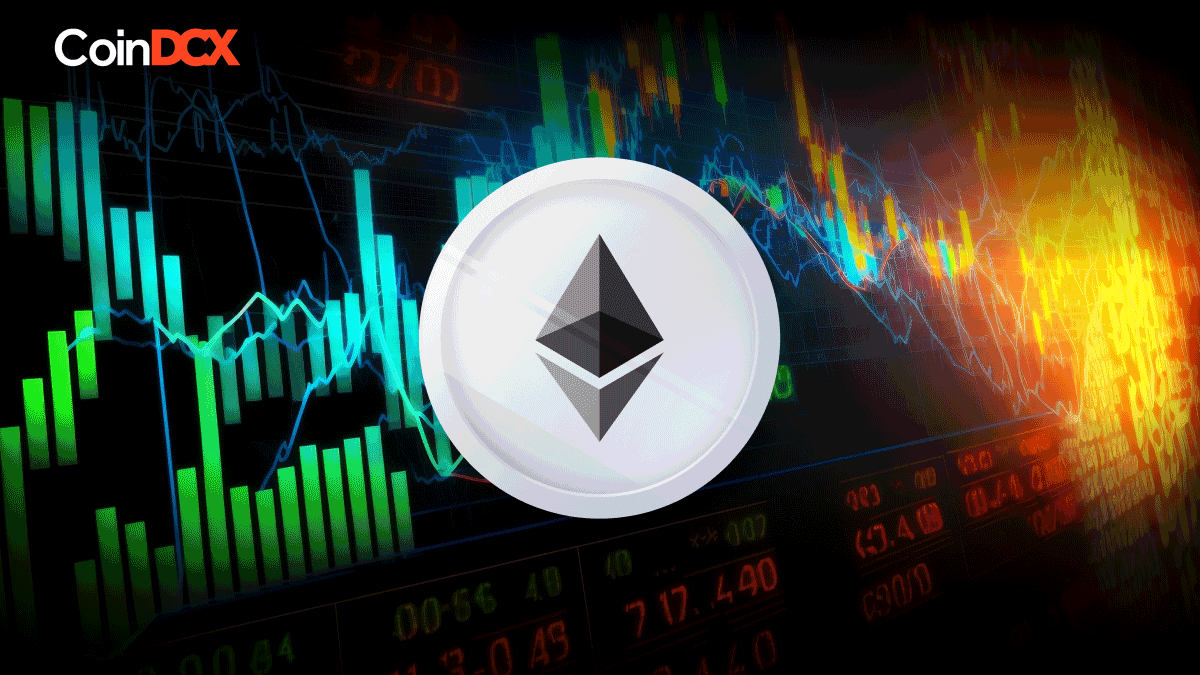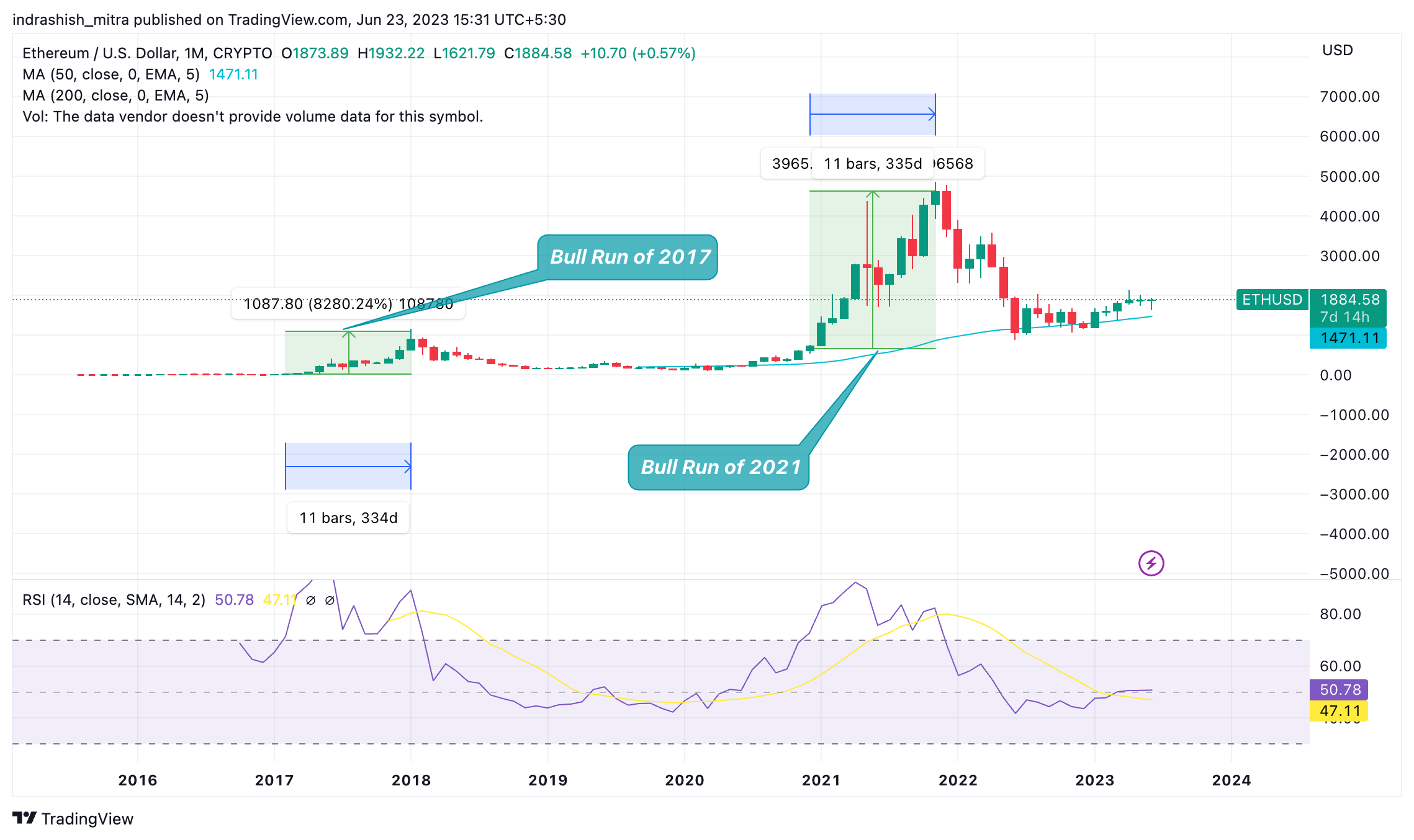Table of Contents
ToggleKey Takeaways:
- Ethereum’s introduction in 2015 revolutionized the crypto market by offering a platform for smart contracts and decentralized applications (dApps).
- Ethereum’s early adoption was driven by its unique features and the potential for building decentralized applications on its blockchain.
- Ethereum currently holds near 20% of the total crypto market cap, showcasing its significance and the trust it has gained from investors and developers.
- Ethereum’s extensive utility and use cases, including DeFi, NFTs, and gaming, have contributed to its market capitalization growth.
- Factors such as Ethereum’s price, market demand, ecosystem growth, investor sentiment, technological upgrades, regulatory environment, and global economic events influence its market capitalization.
Overview Of Ethereum As A Crypto Asset
Ethereum, introduced in 2015 by Vitalik Buterin, is a decentralized platform that enables the development of smart contracts and decentralized applications (dApps). Ethereum has emerged as a significant player in the crypto market, offering unique features and a vast array of use cases. In this section, we will explore the journey of Ethereum, its early adoption, and its significance in the current crypto market landscape.
Early Adoption and Significance:
Since its inception, Ethereum has garnered widespread attention and adoption within the crypto community. While Bitcoin primarily focuses on digital currency, Ethereum expanded the possibilities by introducing a platform for programmable contracts and dApps. This innovative approach attracted developers, entrepreneurs, and enthusiasts who saw the potential for building decentralized applications on the Ethereum blockchain.
Ethereum’s market capitalization is a key metric that reflects its importance and dominance in the crypto market. Market capitalization is calculated by multiplying the total supply of Ethereum by its current market price. Ethereum currently holds near 20% of the total crypto market cap, emphasizing its substantial market presence and the trust it has garnered from investors and developers alike.
One of the primary reasons behind Ethereum’s significant market cap is its extensive utility and use cases. Ethereum provides a platform for developers to create decentralized applications, enabling various functionalities such as financial services, gaming, decentralized finance (DeFi), non-fungible tokens (NFTs), and much more. The versatility and flexibility of the Ethereum platform have fueled its adoption and attracted a diverse community of developers and users.
Ethereum’s market capitalization growth can be attributed to its extensive use cases and the thriving ecosystem built around it. As more projects, dApps, and decentralized finance protocols are built on Ethereum, the demand for Ether (ETH), the native crypto of the Ethereum network, increases. This increased demand has a direct impact on Ethereum’s price and market capitalization.
Moreover, Ethereum’s development and improvement have been driven by a vibrant community and continuous innovation. Ethereum has undergone significant upgrades, including the transition from Proof of Work vs Proof of Stake (PoS) consensus mechanism with Ethereum 2.0, aiming to enhance scalability, security, and sustainability. These advancements contribute to Ethereum’s market capitalization growth and position it as a leading blockchain platform.
Read On: What is Ethereum Cancun-Deneb Upgrade?
Factors Influencing Market Capitalization Growth of Ethereum
- Ethereum Price: The price of Ethereum plays a pivotal role in determining its market capitalization. As the price of Ethereum increases, the market capitalization also grows, reflecting the overall value of the Ethereum network.
- Ethereum Market Demand: The demand for Ethereum is driven by its extensive utility, use cases, and the adoption of dApps built on the Ethereum platform. Increasing market demand for Ethereum leads to higher prices and a subsequent rise in market capitalization.
- Ethereum Ecosystem Growth: The growth of the Ethereum ecosystem, including the development of innovative dApps, DeFi protocols, NFT platforms, and infrastructure projects, contributes to the increasing adoption of Ethereum. This growth fuels demand for Ethereum and influences its market capitalization.
- Investor Sentiment: Investor sentiment, influenced by market trends, news, and confidence in the crypto market, can impact Ethereum’s market capitalization. Positive sentiment often leads to increased investment and higher market capitalization.
- Technological Upgrades: Technological advancements and upgrades in the Ethereum network, such as the transition to Ethereum 2.0, scalability solutions, and improved efficiency, enhance the platform’s capabilities and attract more users and developers. These upgrades positively impact Ethereum’s market capitalization.
- Regulatory Environment: Regulatory decisions and developments regarding cryptos, including Ethereum, can significantly affect market capitalization. Favorable regulations, increased clarity, and broader acceptance by governments and financial institutions can drive market capitalization growth.
- Economic Factors: Economic factors, including inflation, interest rates, global economic stability, and macroeconomic trends, can impact investor sentiment and the overall crypto market, influencing Ethereum’s market capitalization.
- Global Economic Events: Major global economic events, such as recessions, financial crises, or geopolitical developments, can impact investor sentiment and overall market dynamics, including Ethereum’s market capitalization.
By monitoring these factors and staying informed about Ethereum’s price, market trends, and relevant developments, investors and enthusiasts can gain insights into Ethereum’s market capitalization growth and its position within the evolving crypto market.
Key Moments In Ethereum Market History
Key moments in the recent history of the Ethereum market so far:
- The Ethereum Merge: The Ethereum Merge, which occurred last year, was a crucial event in the Ethereum market. It involved merging Ethereum’s existing PoW chain with the Ethereum 2.0 PoS chain. This transition marked a significant step towards Ethereum’s scalability and sustainability goals. The merge attracted attention from investors and the crypto community, contributing to the positive market sentiment around Ethereum and its price growth.
- Ethereum Shanghai Upgrade: The Ethereum Shanghai Upgrade, also known as the Ethereum 2.0 upgrade, is a major milestone in the Ethereum ecosystem. This upgrade aims to improve scalability, security, and sustainability by transitioning from the existing Proof of Work (PoW) consensus mechanism to Proof of Stake (PoS). The announcement of the Shanghai Upgrade had a positive impact on investor sentiment, leading to increased demand for Ethereum and subsequent price appreciation.
- Major Incidents Affecting Ethereum Price:
- Initial Coin Offering (ICO) Boom: During the ICO boom in 2017 and early 2018, Ethereum experienced a surge in price and market capitalization. Many projects launched their ICOs on the Ethereum platform, leading to increased demand for Ether and driving up its price.
- Regulatory Concerns: Regulatory announcements and actions by governments and regulatory bodies regarding cryptos, including Ethereum, have had an impact on its price. Periods of uncertainty or unfavorable regulations can lead to price corrections and volatility.
- DeFi Boom: The rise of decentralized finance (DeFi) applications built on Ethereum in 2020 and 2021 significantly influenced Ethereum’s price and market capitalization. The increased adoption and usage of DeFi protocols propelled demand for Ethereum, driving up its price.
- Market-wide Corrections: Ethereum, like other cryptos, is not immune to market-wide corrections. Price fluctuations in the broader crypto market, influenced by factors such as investor sentiment, global events, and market trends, can affect Ethereum’s price and market capitalization.
- Ethereum Price History: Over the years, Ethereum has experienced notable price fluctuations and growth. Its price history reflects the evolving dynamics of the crypto market and Ethereum’s increasing prominence. By examining Ethereum price charts and historical data, investors can gain insights into past trends and make informed decisions.
- Ethereum Market Capitalization: Ethereum’s market capitalization has witnessed significant growth since its launch. It is influenced by factors such as Ethereum’s price, market demand, ecosystem growth, and investor sentiment. Ethereum’s market cap has reached all-time highs during periods of increased adoption, market enthusiasm, and positive market conditions.
These key moments illustrate significant events that have typically resulted in major positive moves in the price of Ethereum. From the ICO boom to institutional investments and milestones in adoption, these occurrences have played a vital role in shaping the Ethereum market and its price history. Monitoring such events can provide insights into the potential future movements of Ethereum’s price and market capitalization.
Ethereum Market Cap: Trends, Growth, and Future Outlook
As you can observe from the chart above, Ethereum’s market capitalization growth has been stupendous over its brief history of about 8 years since its inception. The most recent bull run of 2021, despite being lower in percentage terms than before, has to have been the most significant in pure dollar terms. The value of Ethereum went from around $30 in 2017 all the way to nearly $4900 at the peak of the bull market of 2021.
The following correction has been pretty severe, things do not seem to be lost yet. With the beginning of the new year of 2023, we saw the value of Ethereum bottoming out, with the lowest values touched in December 2022, ending the raging bear market of the year – and starting the new one with a bang, and the altcoin king is back up nearly 60% in the year-to-date (YTD) timeframe – currently hovering just over the $200 billion market cap value! While there is still a long way to go, almost a 150% rally from here to touch the last all-time-high (ATH) – things look pretty optimistic for now!
Read More: Ethereum Price Prediction
Conclusion
In conclusion, Ethereum has established itself as a prominent crypto asset with a significant market capitalization. Its journey from inception to its current position in the crypto market has been remarkable. Ethereum’s early adoption and its subsequent growth can be attributed to its massive utility and diverse use cases.
With its market capitalization holding near 20% of the total crypto market cap, Ethereum has solidified its position as a leading crypto. Its price history has seen significant fluctuations, driven by market dynamics and various key moments that have impacted its value.
Monitoring Ethereum’s price history, market trends, and historical charts can provide valuable insights into its potential future movements. The Ethereum Shanghai upgrade and the Ethereum merge are examples of key moments that have influenced the Ethereum market and affected its price.
As we move forward, Ethereum’s market capitalization is likely to continue evolving. The year 2023 holds potential for further growth, as Ethereum’s utility expands and its ecosystem continues to mature. By analyzing Ethereum’s market cap by year and its historical chart, investors and enthusiasts can gain a deeper understanding of its trajectory and potential future performance.
It is important to note that investing in cryptos involves risks, and market fluctuations can occur. Therefore, thorough research and careful consideration are advised when making investment decisions related to Ethereum or any other digital asset.
Additional Read: Will Ethereum Price Ever Reach $10,000?
Related posts
Understanding the Different Types of Cryptos: Coins, Tokens, Altcoins & More Explained
Explore the major types of crypto assets and their unique roles.
Read more
PAWS Telegram Game: The New Tap to Earn Game That Is Beating Hamster Kombat
Discover how to play and earn with PAWS Telegram game.
Read more



